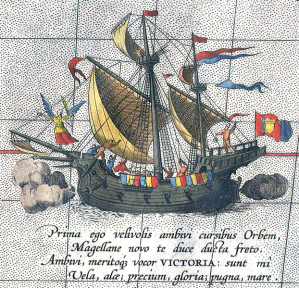
So here we are in the year 1600….
Has Australia been discovered by Europeans already? Are we all done with this search for the Land Down Under?
The Portuguese are the most likely discovers’ at this stage you must say. But exactly when did it happen and who was it?
And if they did why have they not announced such a momentous achievement to the world? Why is not some dashing Portuguese discoverer hailed as a hero in the texts of the time? One argument regarding Portuguese silence is that this discovery was treated as a state secret. Too valuable to share with their competitors. Sharing routes of expeditions to the East was severely punished at the time.
But if no one has reached the shores of Australia, how do we explain the following description by Cornelius Wytfliet of this Great Southern Land in “Descriptionis Ptolemaicae Augmentum”, published in 1598:
“The “Australis Terra” is the most southern of all lands, and is separated from New Guinea by a narrow strait. Its shores are hitherto but little known, since after one voyage and another, that route has been deserted, and seldom is the country visited unless when sailors are driven there by storms. The “Australis Terra’ begins at two or three degrees from the equator, and is maintained by some to be of so great an extent, that if it were thoroughly explored, it would be regarded as a fifth part of the world.”
It is within reason that Australia had been accidentally visited during the sixteenth century and this is supported by the Dieppe maps to an certain extent. One French map of dated 1542, presents an outline that might support at least one Portuguese ship sailing from Cape York to Tasmania.
So in the year 1600 we have boastful claims of seamen and privateers, a few intriguing charts and the statement of Cornelius Wytfliet as milestones of achievement.
However, let’s move into a new century. Here, surely, we are bound to find a seaman we can be more confidently say sailed within sight of, or strode ashore on, this Great Southern Land.
Enter Pedro Fernandez de Quiros, a Spanish seaman with an unshakable belief in the existence of the Great Southern Land. In 1598 he petitioned King Phillip III of Spain to commission an expedition to find this mythical continent. Successful in gaining the King’s assent, he sails three ships from Peru in 1605 to claim this continent for Spain and the Church. Second in command was Luis de Torres.
All was not well, however, on Quiros’s ship. During the voyage it appears Quiros’s crew mutinies, and he is forced to sail back to Peru, leaving Torres in command of the remaining two ships.
Torres was known as an able seaman. He apparently searched for his lost commander and then sailed towards the southern coast of New Guinea through the strait that now bear his name. Intriguingly, he did seem to know of the strait – that it would lead him back to the open seas and to eventually the Philippines. This knowledge again leads to the prospect that someone, most likely the Portuguese, has previously circumnavigated New Guinea and charted their voyage.
But did Torres hug the New Guinea coast line, or venture along the Australian Coast line further to the south? Strong arguments exist; based on the prevailing winds (north east trade winds) that he is likely to have sailed through the Endeavour Straight, past Thursday Island. This would have put him in sight of Cape York, the northern tip of Australia.
Torres did not claim to discovery Australia. If he saw it he did not recognise his find. Indeed, much of his account of his trip gathered dusk in the Spanish archives and his voyage achieved little celebration. That is until by various hands, it is likely his notes found there way in the 1760’s to Joseph Banks and then to Captain Cook .
On the other hand, Torres’s disappearing Captain Quiros, announced in 1610 that he had discovered the large southern continent. In doing so he proclaimed it “Austrialia del Espiritu Santo” (in honour of Phillip III, a member of the “House of Austria”).
So is Torres our discoverer? Or, at least first European to sight Australia? Well, the argument although not conclusive, is sound.
However, you get that sneaking feeling, that just by knowing the strait between New Guinea and Australia existed, that those Portuguese had probably been there before. And if the trade wind logic applies to Torres, well it must apply to the Portuguese as well.
I am suspecting we may never know…but let’s keep searching anyway ….
 A little about the history of the Great Southern Land….
A little about the history of the Great Southern Land….



 What has Ceuta, northern Africa, barely 20 km across the straight of Gibraltar got to do with the Discovery of Terra Australis?
What has Ceuta, northern Africa, barely 20 km across the straight of Gibraltar got to do with the Discovery of Terra Australis?
 The last byte introduced the logical argument for a Southern Land. Let’s move to more earthly and tactile experiences.
The last byte introduced the logical argument for a Southern Land. Let’s move to more earthly and tactile experiences.






